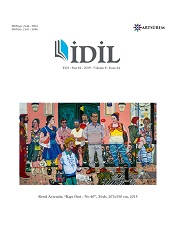Cumhuriyet Sonrası Türk Resminde Konya'yı Tema Edinen Sanatçılar ve Eserleri
The Artists Who Themed Konya and Their Works at Turkish Painting After Republic
Author(s): İbrahim Çoban, Hasan IşikSubject(s): Cultural history, Architecture, Visual Arts, Local History / Microhistory, Social development, Rural and urban sociology, History of Art
Published by: Sanat ve Dil Araştırmaları Enstitüsü
Keywords: Contemporary Turkish Painting Art; Konya; Konya Landscapes; Konya Interpretations;
Summary/Abstract: The urban concept that emerged towards the end of the 4000 B.C. caused establishment and development of trade, culture and ideologies depending on the settled order of human being and the transition to agrarian society. City Konya that is one of the most important and major cities of Turkey regarding to socio-cultural perspective and that was capital city of Anatolian Seljuk State, was built on facts inherited from Seljukian and Ottoman civilizations and so carries great the historical and cultural heritage on it. The city has Seljuk and Ottoman architectural works together with Mawlana Celaleddin-i Rumi's spiritual heritage; it is seen that this city became theme of many artists' paintings especially in the post-Republican Turkish Painting period. The artists who themed Konya in their paintings and the Konya depicted in their works have been examined in this study. It is emphasized that which artists gave place and interpreted Konya in their works in Post-Republic Turkish Painting. Consequently, Konya views and their interpreting styles Konya in works of artists like Hüseyin Rıfat Çeteci, Şefik Bursalı, Şehabeddin Uzluk, Saim Özeren, Refik Epikman, Zeki Kocamemi, Ferruh Başağa, Ahmet Yakupoğlu, Salih Nuri Urallı, İlham Enveroğlu, Nihat Şirin, Halit Bardakçı, Mehmet Başbuğ, Nesip Koçer, İbrahim Kuzey, Mehmet Büyükçanga, Muhsin Kaleli, Hüseyin Elmas, Ahmet Dalkıran, İbrahim Çoban, Hasan Işık was searched. The research was carried out the city Konya regarding to as a complementary element at background of works and landscape and interpretive context. After assessing the data obtained from literature scanning and qualitative research methods; it is thought that obtained results will make gain a different aspect to artists who are in effort of creating an original language in Contemporary Turkish Painting. At the same time, it is predicted that the ways of thinking and the plastic values created by the composition fictions of the paintings will contribute to the artist in the context of contemporary art.
Journal: İdil Sanat ve Dil Dergisi
- Issue Year: 8/2019
- Issue No: 64
- Page Range: 1869-1894
- Page Count: 26
- Language: Turkish

